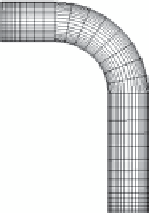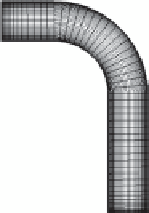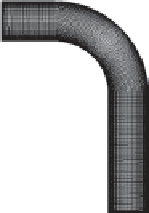Biomedical Engineering Reference
In-Depth Information
FRDUVHPHVK
FHOOV
PHGLXPPHVK
FHOOV
ILQHPHVK
FHOOV
a
b
c
FRDUVH
PHGLXP
ILQH
GLVWDQFHIURPZDOO
YHORFLW\SURILOHVIRUPHVK
d
Fig. 6.20
Mesh independence study for three different mesh designs on a 90° bend. The velocity
magnitudes are taken after the bend where the flow recovers.
a
coarse mesh (700 cells)
b
medium
mesh (2100 cells)
c
fine mesh (8500 cells)
d
velocity profiles for mesh
field variable should be checked at each mesh to monitor its value or profile. The
mesh is considered independent when the flow variable does not change with an
increase in the mesh size. This leads to a mesh that has optimised and grid indepen-
dent where a compromise between computational resources and accuracy has been
made. Figure
6.20
shows a typical mesh independence test on a 90° bend geometry
and its influence on a velocity profile taken just after the bend where the flow begins
to recover. The results show that as the mesh is increased to a medium and further
increased to a fine mesh, the results begin to converge, and hence reaching indepen-
dence from the mesh density
6.5
Meshing Examples
In this section we first present practical examples, mesh designs, and guidelines that
will accelerate a new student to mesh generation which is aimed at giving an insight
into the practical strategies and techniques for mesh generation.





Search WWH ::

Custom Search